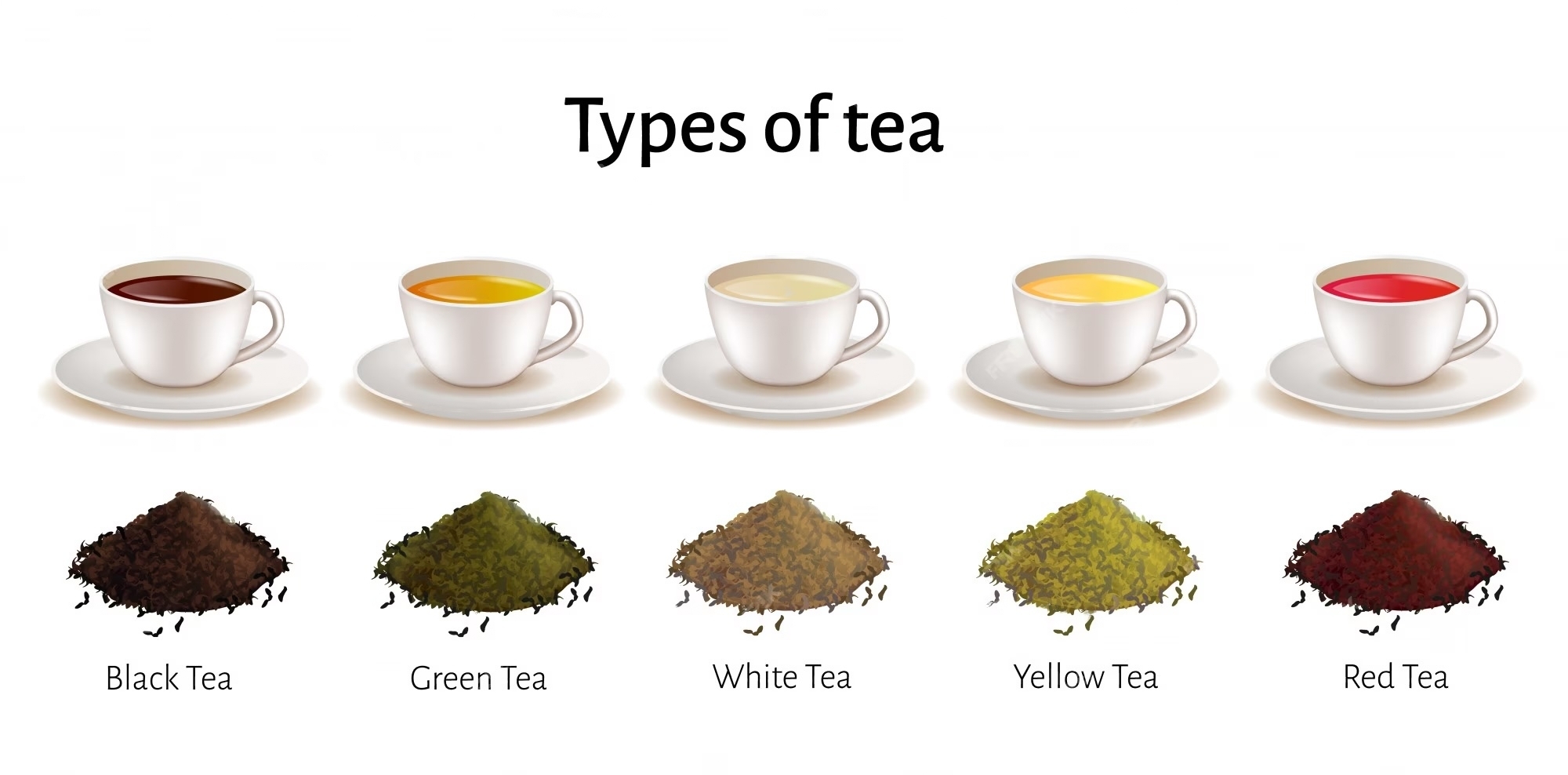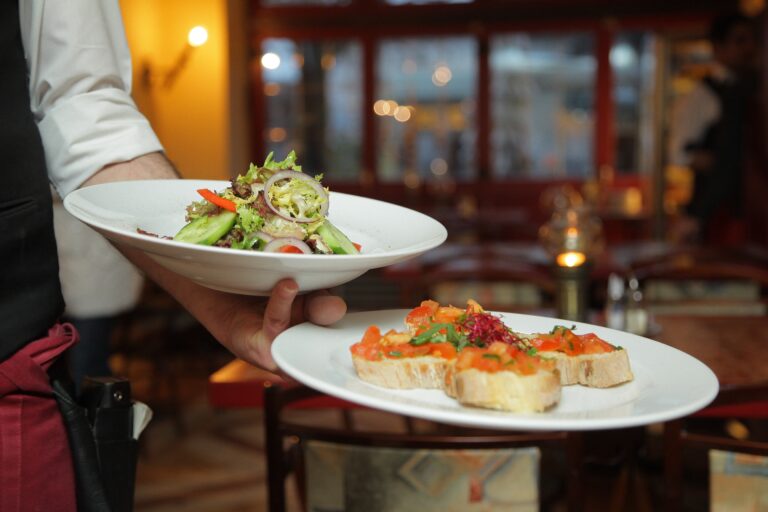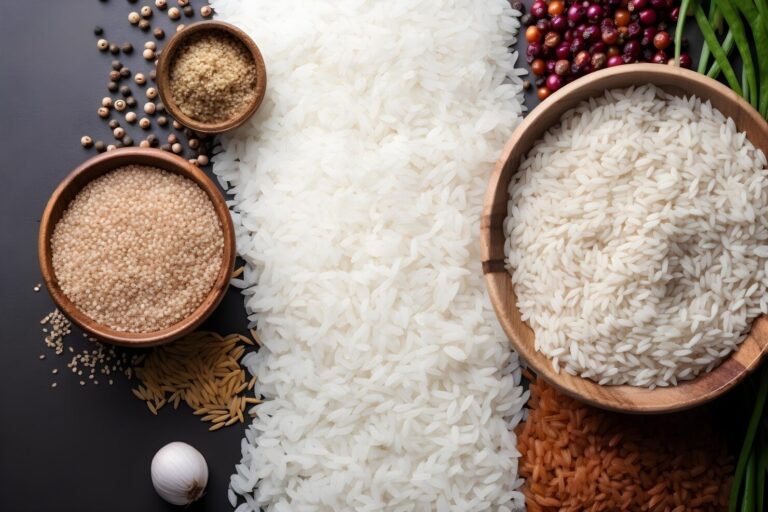Tea Types Guide – Exploring Different Varieties
1. Introduction
The tea-type Guide and Origins of Tea
Tea is not just a beverage; it’s a cultural cornerstone that has been enjoyed for millennia. The story of tea begins in ancient China, where legend has it that Emperor Shen Nong discovered tea when tea leaves blew into a pot of boiling water he was preparing. This serendipitous event marked the birth of the world’s most consumed beverage after water.
The Camellia Sinensis Plant
All true teas, be it white, green, oolong, black, or pu-erh, come from the leaves of the Camellia sinensis plant. The differences in these tea types are a result of variations in processing, oxidation, and region. Understanding this foundation is crucial to appreciating the rich diversity of tea.
2. Understanding Tea Types Guide
White Tea
The least processed of all tea types is White tea. Its delicate flavor and minimal oxidation give it a subtle, floral taste. It’s known for its high levels of antioxidants and low caffeine content, making it a favorite among those seeking a milder tea experience.
Green Tea
Green tea, with its grassy and fresh taste, has been a staple in Asian cultures for centuries. It’s celebrated for its health benefits, including weight management and its potential to reduce the risk of chronic diseases.
Oolong Tea
Oolong tea falls somewhere between green and black tea in terms of oxidation. It boasts a wide range of flavors, from light and floral to deep and rich. Oolong tea is often praised for its complexity and versatility.
Black Tea
Because black tea has undergone complete oxidation, its flavor is strong and powerful. It’s the most popular tea variety in the Western world, often enjoyed with milk and sugar.
Pu-erh Tea
Pu-erh is a fermented tea that gains value with age. Its earthy and woody flavors make it a unique and acquired taste. Pu-erh is also believed to have digestive and weight management properties.
3. Herbal and Infusions Tea Types Guide
Chamomile
Tea made with chamomile is well known for being tranquil and comforting. It’s an herbal infusion made from dried chamomile flowers and is caffeine-free.
Peppermint
Peppermint tea is refreshing and invigorating. It’s a popular choice for its minty flavor and potential digestive benefits.
Rooibos
Rooibos, or red bush tea, is a South African herbal tea. It’s caffeine-free and known for its earthy and slightly sweet taste.
Hibiscus
Hibiscus tea is not only visually stunning with its deep red hue but also tart and tangy in flavor. It’s enjoyed both hot and cold and is believed to have various health benefits.
Chai
Chai is a spiced tea originating from India. It’s a blend of black tea and a mix of aromatic spices like cardamom, cinnamon, and cloves. Chai is frequently consumed with milk and sugar.
4. Tea Production Process
Plucking
The tea-making process begins with the careful plucking of tea leaves. Different grades of tea may use different leaves, from young and tender buds to more mature leaves.
Withering
Withering involves wilting the leaves to reduce their water content. This step can be done naturally by spreading the leaves out, or artificially by using fans.
Rolling
The rolling process helps to release the essential oils in the leaves. It also shapes the leaves into the desired form, which can vary from long and twisted to small and round.
Oxidation
Oxidation is a critical step that determines the type of tea produced. For example, green tea is minimally oxidized, while black tea is fully oxidized.
Firing
The final step involves firing the leaves to stop oxidation and lock in the flavor. Different firing methods and temperatures contribute to the unique characteristics of each tea.
5. Brewing the Perfect Cup as per Tea Types Guide
Water Temperature
The ideal water temperature varies for each tea type. Green teas usually require cooler water, while black teas can withstand hotter temperatures.
Steeping Time
Steeping times should be carefully monitored. Over-steeping can result in bitter tea, while under-steeping may lead to a weak brew.
Tea Equipment
Investing in quality tea equipment can greatly enhance your tea experience. Teapots, infusers, and kettles are essential tools for any tea enthusiast.
Loose Leaf vs. Tea Bags
Loose-leaf tea is often considered superior in flavor and quality compared to tea bags. However, tea bags offer convenience.
The Art of Tea Tasting
Tea tasting is a sensory experience that involves evaluating the appearance, aroma, taste, and mouthfeel of the tea. It’s a skill that can be developed with practice.
6. Cultural Significance of Tea Types Guide
Chinese Tea Culture
China, often considered the birthplace of tea, has a rich tea culture that spans thousands of years. Traditional Chinese tea ceremonies are elaborate, emphasizing the art of brewing and sharing tea.
Japanese Tea Ceremony
The Japanese tea ceremony, known as Chanoyu or Sado, is a highly ritualized practice that combines the preparation and consumption of matcha, a powdered green tea. It incorporates elements of Zen Buddhism and Japanese aesthetics.
British Afternoon Tea
Afternoon tea is a cherished tradition in the United Kingdom. It typically includes a selection of teas, finger sandwiches, scones, and a variety of cakes. It’s a delightful social occasion.
Moroccan Mint Tea
Moroccan mint tea, or “atai,” is a symbol of hospitality in Moroccan culture. This green tea is infused with fresh mint leaves and sugar and is served in ornate teapots.
Indian Chai
Chai, a spiced tea with milk and sugar, holds a special place in Indian culture. It’s not just a drink; it’s a social activity that brings people together.
7. Health Benefits of Tea
Antioxidants
Tea is a rich source of antioxidants, particularly in green and white teas. These compounds help protect the body from oxidative stress and may reduce the risk of chronic diseases.
Caffeine Content
The caffeine content in tea varies by type. If you’re looking for a milder caffeine boost, opt for white or green tea. For a stronger kick, black tea is the way to go.
Weight Management
Some studies suggest that the combination of caffeine and antioxidants in tea can support weight management efforts by boosting metabolism and fat oxidation.
Stress Relief
The act of making and sipping tea can be a calming ritual. Certain herbal teas, like chamomile and lavender, are known for their stress-relieving properties.
Digestive Aid
Peppermint and ginger teas are often used to soothe digestive issues. They can help alleviate indigestion and reduce bloating.
8. Tea and Food Pairing
Pastries and Desserts
Tea and pastries are a classic pairing. Light teas, such as green or white, complement sweet treats like macarons, while black teas stand up well to richer desserts like chocolate cake.
Savory Dishes
Tea isn’t just for sweet pairings. It can enhance the flavors of savory dishes. Experiment with oolong tea and seafood or pu-erh tea with spicy foods.
Cheese and Tea Pairings
Tea and cheese share complex flavor profiles. Try pairing oolong tea with nutty cheeses or black tea with sharp cheddars for a delightful taste experience.
Tea Cocktails
Tea can be a base for creative cocktails. Earl Grey-infused gin, green tea mojitos, and chai-spiced whiskey are just a few options for tea enthusiasts with a taste for mixology.
9. The Art of Blending Teas in Tea Types Guide
Tea Blending Techniques
Tea blending is an art that involves combining different tea varieties, herbs, spices, or floral elements to create unique flavors and aromas.
Creating Your Signature Blend
Creating your own tea blend can be a fun and rewarding hobby. It allows you to tailor your tea to your exact preferences.
Commercial Tea Blends
Many tea companies offer expertly crafted blends that cater to various tastes and occasions. These blends are often inspired by cultural traditions and culinary trends.
10. Tea in Pop Culture
Literature and Tea
Tea has made numerous appearances in literature, from Mad Hatter’s tea party in “Alice in Wonderland” to the importance of tea in “The Book Thief.”
Films and Tea Scenes
Tea is frequently featured in films as a symbol of sophistication or a means of connection. Iconic tea scenes can be found in movies like “Pride and Prejudice” and “Kill Bill.”
Tea in Music
Tea has inspired song lyrics and even entire albums. Artists like KT Tunstall and Belle and Sebastian have paid tribute to the comforting ritual of tea.
Tea Quotes
Writers, philosophers, and celebrities have offered their wisdom about tea. Quotes about tea range from humorous to profound, reflecting its diverse cultural impact.
11. Tea-Related Travel Destinations
Darjeeling, India
Darjeeling, known as the “Champagne of Teas,” is a picturesque region in India known for its high-quality tea plantations.
Kyoto, Japan
Kyoto’s historic tea houses and lush tea gardens are a must-visit for anyone interested in Japanese tea culture.
Hangzhou, China
Hangzhou, the capital of Zhejiang province, is home to Longjing tea and the stunning West Lake, providing a serene backdrop for tea enthusiasts.
Sri Lanka
Sri Lanka, formerly Ceylon, is celebrated for its Ceylon tea, a bright and brisk black tea.
England
A trip to England wouldn’t be complete without experiencing a traditional afternoon tea, complete with scones, clotted cream, and cucumber sandwiches.
12. Tea-Related Travel Destinations
Darjeeling, India
Darjeeling, known as the “Champagne of Teas,” is a picturesque region in India known for its high-quality tea plantations. The cool climate and high altitudes produce teas with a unique muscatel flavor. Visitors to Darjeeling can explore lush tea gardens and enjoy guided tours to learn about the tea production process. Don’t forget to savor a cup of Darjeeling tea while taking in the breathtaking views of the Himalayas.
Kyoto, Japan
Kyoto’s historic tea houses and lush tea gardens are a must-visit for anyone interested in Japanese tea culture. The traditional Japanese tea ceremony, or Chanoyu, is an integral part of Kyoto’s cultural heritage. Visitors can witness tea ceremonies and even participate in them. The serene atmosphere of Kyoto’s tea houses and gardens provides a profound connection to Japan’s history and traditions.
Hangzhou, China
Hangzhou, the capital of Zhejiang province, is home to Longjing tea, one of China’s most famous green teas. The city’s West Lake region boasts stunning landscapes that have inspired poets and artists for centuries. Visitors to Hangzhou can take boat rides on West Lake, visit tea plantations, and taste the refreshing and delicate flavors of Longjing tea. The city’s tea culture is deeply rooted in its history and can be explored through various tea-themed activities.
Sri Lanka
Sri Lanka, formerly Ceylon, is celebrated for its Ceylon tea, a bright and brisk black tea known for its bold flavor and rich aroma. The country’s tea plantations are nestled in picturesque landscapes with rolling hills and terraced fields. Travelers can embark on guided tours of these plantations, witnessing the plucking and processing of tea leaves. Sipping a cup of Ceylon tea in the heart of its production region is an experience not to be missed.
England
A trip to England wouldn’t be complete without experiencing a traditional afternoon tea. The custom of afternoon tea, introduced by Anna, the Duchess of Bedford in the early 19th century, remains a delightful and quintessentially British tradition. Guests can indulge in an assortment of finger sandwiches, scones with clotted cream and jam, and a selection of fine teas. English tearooms, often set in elegant surroundings, offer a glimpse into the country’s tea heritage and its role in socializing.
13. Tea and Mindfulness
Tea Meditation
Tea meditation is a practice that combines the art of brewing and savoring tea with mindfulness. It encourages being fully present in the moment and appreciating the sensory aspects of tea. Tea meditation is an excellent way to reduce stress and increase awareness.
Mindful Tea Drinking
Mindful tea drinking is a daily ritual for many tea enthusiasts. It involves taking time to appreciate the aroma, taste, and texture of the tea. Practicing mindful tea drinking can enhance your connection with the beverage and promote relaxation.
The Zen of Tea
In Zen Buddhism, the act of preparing and serving tea is considered a form of meditation. The simplicity and intentionality of tea ceremonies align with the Zen philosophy, emphasizing the importance of being fully engaged in the present moment.
14. Tea Myths and Legends
The Legend of Shen Nong
The legend of Emperor Shen Nong is an ancient Chinese tale that attributes the discovery of tea to him. According to the legend, Shen Nong was a herbalist who tasted hundreds of plants, including tea, to discern their medicinal properties.
The Boston Tea Party
The Boston Tea Party, a pivotal event in American history, involved the protest of the British-imposed tea tax. In 1773, American colonists, disguised as Native Americans, boarded British ships and dumped chests of tea into Boston Harbor as a protest against taxation without representation.
The Tale of Earl Grey
Earl Grey tea, a beloved black tea flavored with bergamot oil, is named after Charles Grey, the 2nd Earl Grey and Prime Minister of the United Kingdom in the 1830s. The origin of this delightful blend is shrouded in myth, making it a subject of fascination for tea enthusiasts.
The Origin of Chai
Chai, the spiced tea from India, has a rich history. It’s believed to have originated from Ayurvedic traditions, where spices were used for their healing properties. Today, chai is enjoyed worldwide for its aromatic and warming flavors.
15. Tea for Every Season as per the tea-type guide
Spring Teas
Spring is the season of freshness, and tea reflects that in its bright and delicate flavors. Green and white teas, with their floral and grassy notes, are popular choices during this time.
Summer Refreshments
In the heat of summer, iced teas and herbal infusions are go-to choices. These beverages offer a cooling and hydrating respite during sweltering days.
Fall Flavors
As the weather cools down, teas with warm, earthy, and spiced flavors come into play. Chai and black teas with cinnamon and nutmeg are perfect for autumn.
Winter Warmers
Winter calls for comforting and warming teas. Chai, black teas with honey and citrus, and herbal blends with ginger and clove provide solace during the cold months.
16. Sustainability in the Tea Industry by Tea Types Guide
Organic Tea Farming
The demand for organic products is on the rise, and the tea industry is no exception. Organic tea farming eschews synthetic pesticides and fertilizers, promoting soil health and biodiversity.
Fair Trade Tea
Fairtrade practices ensure that tea workers receive fair wages and work in humane conditions. Buying fair trade tea supports social and environmental sustainability in tea-producing regions.
Eco-Friendly Packaging
Sustainable packaging is becoming a priority for tea brands. Biodegradable tea bags, recyclable packaging, and reduced plastic usage are some of the eco-friendly approaches adopted by the industry.
Ethical Tea Sourcing
Many tea companies are actively sourcing their teas in an ethical manner. This means engaging with local communities, respecting their rights, and ensuring sustainable farming practices.
17. Tea as a Lifestyle as per Tea Types Guide
Tea Ceramics and Utensils
Tea is often closely associated with exquisite ceramics and utensils. The design and craftsmanship of teapots, cups, and utensils contribute to the overall tea-drinking experience.
Tea and Art
Tea has been a muse for artists for centuries. It’s a subject in paintings, sculptures, and other forms of art, reflecting the cultural significance and aesthetic appeal of tea.
Tea and Fashion
Tea culture has inspired fashion trends. From tea-themed clothing to accessories, tea enthusiasts express their love for the beverage through their style.
Tea in Interior Design
Tea can be a central theme in interior design. Tea rooms, dedicated corners for tea, and the use of tea-related decor elements create inviting and serene spaces.
18. Tea Traditions Around the World
Russian Samovar
The samovar is an iconic tea-brewing apparatus in Russia. It’s a heated metal container that keeps water hot for brewing tea. Russians have a rich tea-drinking tradition that often involves the samovar and a variety of accompaniments.
Moroccan Tea Ritual
Moroccan mint tea, or “atai,” is an integral part of Moroccan culture. The preparation and serving of this tea involve rituals and are a symbol of hospitality.
Turkish Tea Culture by tea type guide
Tea is a way of life in Turkey. Turkish tea, often served in tulip-shaped glasses, accompanies social gatherings, conversations, and daily life.
Taiwanese Gongfu Cha
Gongfu Cha is a traditional Chinese tea ceremony that has influenced tea culture in Taiwan. It emphasizes the art of brewing tea in small teapots and multiple infusions.
Argentine Yerba Mate
Yerba mate is a traditional South American drink, especially popular in Argentina. It’s a type of herbal tea brewed from the leaves of the yerba mate plant and enjoyed communally.
19. Tea in the Modern World
Tea Trends as per Tea Type Guide
Tea trends evolve, and the modern tea scene is no longer limited to traditional options. Bubble tea, matcha lattes, and tea-infused cocktails are some of the contemporary tea trends.
Tea Subscription Boxes
Tea subscription services deliver curated selections of teas to your doorstep. It’s a convenient way to explore new flavors and types of tea.
Tea Apps
There are apps for everything, and tea is no exception. Tea apps offer guidance on brewing, tasting notes, and even tea-focused social networks.
Online Tea Communities
The internet has brought tea enthusiasts together from all over the world. Online forums, blogs, and social media groups provide platforms for sharing and discussing tea experiences.
20. Conclusion: Your Tea Journey Begins
Explore and Experiment
The world of tea is vast and diverse. Take the opportunity to explore different tea types, flavors, and brewing methods. Your tea journey is a personal adventure.
Share Your Tea Discoveries
Tea is often best enjoyed with others. Share your love for tea with friends and family. Host tea parties, introduce others to new flavors, and savor the camaraderie that tea can bring.
Embrace the World of Tea Types
Whether you’re a seasoned tea connoisseur or just beginning to explore the world of tea, remember that tea is more than a beverage. It’s a reflection of culture, history, and the simple joy of life’s rituals.
With this comprehensive Tea Types Guide, you’re well-equipped to embark on your own tea-tasting adventure, exploring the myriad flavors and traditions that tea has to offer.






